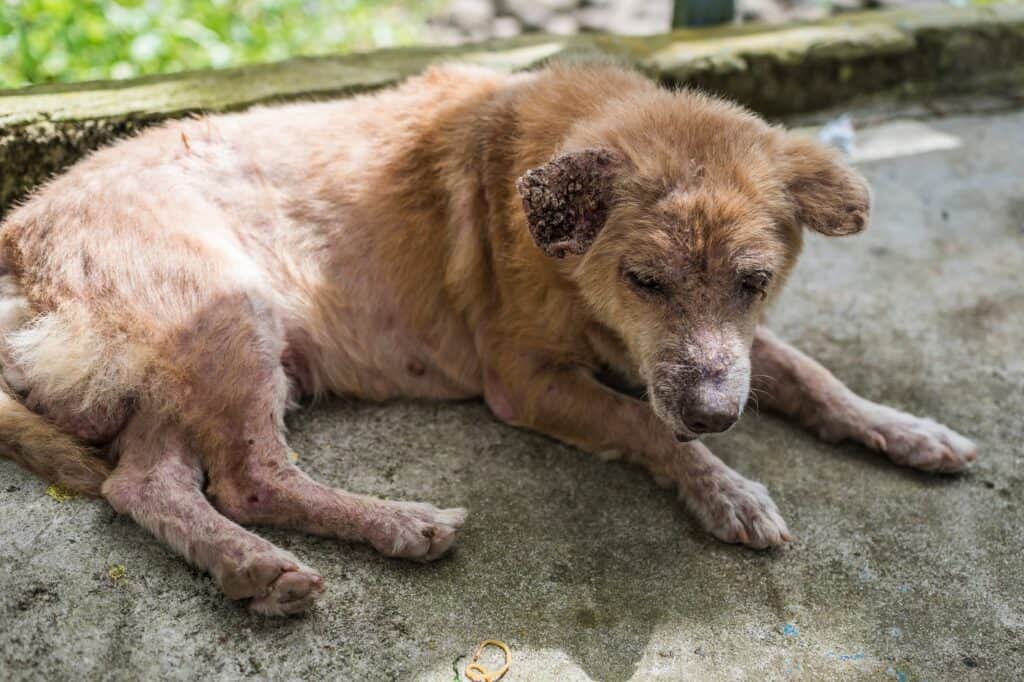Mange in dogs is one of the most visible, common infections to afflict our canine companions. But, did you know that there are actually two types of mange, each with very different treatments and prognoses? If you’re a dog owner, it’s important to understand the early signs of mange, and what you need to do to treat it. But, don’t worry: mange is a very treatable disease, and almost all dogs make a full recovery from even the most severe of infections.
Here, we’ll discover just what mange is, what causes it, and how to tell the difference between the two types. Then, we’ll find out how dogs get this skin infection, and what can be done to treat it. Further, we’ll take a deep dive into exactly how the two types of mange differ, and why it’s important. Finally, we’ll go over whether or not either type of mange is contagious to dogs or humans.
What is Mange?

Mange is a skin infection caused by parasites.
©MDV Edwards/Shutterstock.com
Mange is a relatively common skin infection that afflicts dogs. It’s caused by parasitic mites that are so small they can only be seen through a microscope. Importantly, there are two distinct types of mange: demodectic mange, and sarcoptic mange. Demodectic mange is caused by the Demodex injal or Demodex canis mite, whereas sarcoptic mange is caused by the Sarcoptes scabiei mite. Both types of mange can be resolved with treatment by a veterinarian.
The Two Types of Mange
There are two types of mange in dogs: demodectic mange and sarcoptic mange, known colloquially as red mange and scabies (respectively). In demodectic mange, mites live in the dog’s hair follicles. In sarcoptic mange, they actually live in the skin’s surface layer, where females lay their eggs.
But, why is it important to know what type of mange your dog has? Well, each type of mange has its own cause, as well as treatment. Additionally, only one is contagious. Let’s find out more about where mange comes from, and what to do about it if it afflicts your furry friend.
How Do Dogs Get Mange?

Demodectic mange is caused by Demodex mites.
©Kalcutta/Shutterstock.com
In dogs, demodectic mange is most commonly seen in young puppies, older dogs, or neglected stray dogs. Interestingly, most dogs (and people) harbor a few demodectic mites in their hair. But, strong immune systems prevent infections from taking hold. Dogs get demodectic mange when they have compromised immune systems, such as in neglected or older, health-compromised dogs. In puppies, demodectic mange becomes an issue when mothers pass immune deficiencies onto their puppies. These immune-compromised puppies develop mange infections which often recur until adulthood.
Sarcoptic mange, however, can be spread to even the healthiest of canines. Sarcoptic mites spread from infected dogs; they can even take up residence in human skin.
How Do You Know if Your Dog Has Mange?
In demodectic mange, hair loss usually starts on the face and around the eyes. Afflicted dogs may or may not become itchy initially. Sarcoptic mange travels from canine to canine and may take up to eight weeks to become symptomatic. Typically, sarcoptic mange first shows up in the elbows, chest, belly, hocks, or edges of the ears. Dogs with sarcoptic mange display extreme itching, redness, hair loss, and yellow crusts of skin at the site(s) of infection. With both types of mange, localized infections quickly spread into generalized infections without combative treatment.
Can Humans Catch Mange From Dogs?
The mites responsible for demodectic mange live in small numbers on nearly all dogs and humans. They only become a problem if the immune system is compromised. So, as long as you have a healthy immune system, you cannot catch demodectic mange from your furry friend. Sarcoptic mange is a whole other story; it can easily transfer from dogs to humans, though people aren’t their favorite food.
How Do You Treat Mange?

Mange is treatable. Consult your vet if you see the symptoms on your dog.
©Yavdat/Shutterstock.com
There are many ways to treat both types of mange, but the only approved, safe way is through topical (usually a cream rubbed into the skin) medications. Extreme cases of demodectic or sarcoptic mange may cause additional skin infections, which require further treatment by a veterinarian to resolve. Mange is treatable, though dogs may be reinfected until their immune systems fully mature, around 18 months of age.
If you suspect that your canine companion has either form of mange, make an appointment with your vet immediately. Do not attempt to treat the problem on your own, as only the vet can determine which type of mange your dog has, and whether or not there are compounding infections or conditions.
Is Mange Contagious?
Fortunately, demodectic mange is not contagious, either to dogs or humans. Sarcoptic mange, however, is highly contagious, both to humans and canines. Dogs with sarcoptic mange should remain isolated from other pets in the home and should be handled according to veterinary instructions.
Up Next
- The 5 Ways Dogs Get Mange, and How to Help Them Heal
- What Kills Ticks on a Dog Instantly?
- Can Dogs Get Skin Tags?
The photo featured at the top of this post is © iStock.com/Thanawath Seangsuriyapone
Ready to discover the top 10 cutest dog breeds in the entire world?
How about the fastest dogs, the largest dogs and those that are -- quite frankly -- just the kindest dogs on the planet? Each day, AZ Animals sends out lists just like this to our thousands of email subscribers. And the best part? It's FREE. Join today by entering your email below.
Sources
- , Available here: https://vcahospitals.com/know-your-pet/mange-demodectic-in-dogs#:~:text=Mange%20is%20a%20parasitic%20skin,hair%20follicles%20(demodectic%20mange)
- , Available here: https://www.akc.org/expert-advice/health/mange-what-you-need-to-know/
Thank you for reading! Have some feedback for us? Contact the AZ Animals editorial team.






